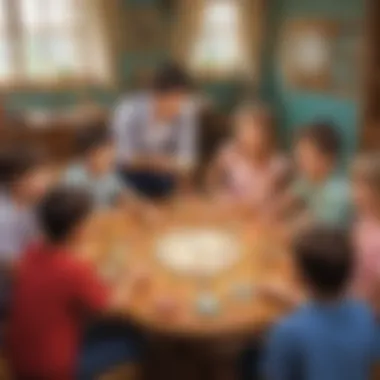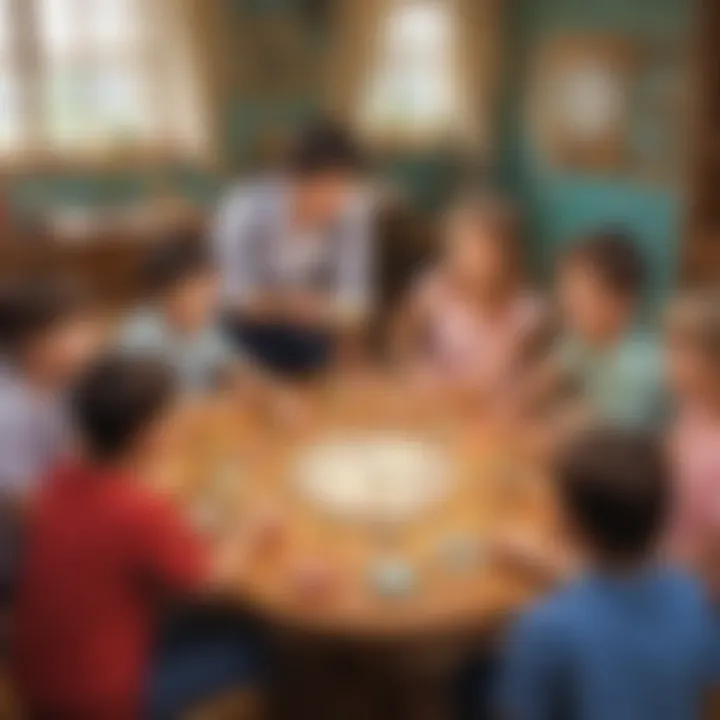Exploring the Educational Benefits of Time-Telling Games


Intro
Understanding time isn't just a skill; it's an essential part of our everyday lives. For children, learning how to tell the time propels them beyond just asking, "When is lunch?" or "How long until recess?". It introduces them to concepts of planning, responsibility, and punctuality—all invaluable life skills. Through play, specifically with the telling the time game, kids can grasp these ideas in an engaging and enjoyable manner, turning what may seem a tedious task into an exciting adventure.
As we delve into the creative activities, quizzes, and informative articles that surround the telling the time game, the aim is to provide useful insights for parents, caregivers, and teachers alike. Ultimately, these elements work together to develop a well-rounded learning environment that emphasizes fun. So let’s explore how these activities foster understanding of time while ensuring children enjoy the process.
Creative Activities
Engaging children through play is a powerful method for fostering important skills. Here are some creative activities to consider when introducing the telling the time game.
Craft Ideas
- Clock Faces: Kids can create their own clock faces using paper plates. They can draw numbers, stick on symbols, or even use pasting materials for a 3D effect.
- Time Telling Bingo: Making bingo cards with different times on them can make learning competitive and fun. Children will have to recognize and call out the time shown on their cards when shown by the teacher or parent.
- Paper Mache Clocks: A slightly messier but very entertaining option could be crafting a full clock using paper mache. As they assemble it, children can learn about clock structure while their creativity shines.
Step-by-Step Guides
- Creating a Clock Face:
- Organize a Time Telling Bingo:
- Crafting Paper Mache Clocks:
- Gather materials: paper plates, markers, scissors, and a brad.
- Draw the numbers on the plate in a circular pattern.
- Cut out two hands from cardboard, then attach them at the center with the brad.
- Design several bingo cards filled with time combinations.
- Make sure each card is different.
- Prepare calls for each time to keep the game moving.
- Blow up a balloon and layer strips of newspaper soaked in glue all around it.
- Once dry, pop the balloon and draw or attach numbers and hands to make a functioning clock.
Educational Value
Craft activities encourage fine motor skills and creative thinking. At the same time, they reinforce time concepts — becoming a memorable learning experience instead of just a lesson. Moreover, such hands-on activities bolster critical thinking as children learn to make their own clocks, understand clock construction, and even explore the way time operates in different contexts through discussions.
Fun Quizzes
Quizzes may not usually stir excitement, but when they revolve around game formats, they can play a significant role in retention and understanding.
Quiz Topics
Some potential quiz categories could be:
- Digital vs. Analog Time: This helps kids differentiate between different ways of displaying time.
- Time in Daily Life: Questions where they relate specific times to daily activities, like meals and wake-up times.
- Time Conversion: Converting hours into minutes, seconds, or even 24-hour formats can be quite enlightening for older children.
Question Types
- Multiple Choice: This format allows children to pick the correct time when presented with several options, testing their memory and comprehension.
- True/False: Simple statements about time can help assess children’s understanding.
- Fill in the Blanks: Presenting partial sentences related to clocks can encourage critical thinking and recall.
Knowledge Reinforcement
Quizzes can offer immediate feedback which is essential for learning. They not only make learning feel interactive but also provide both children and educators a point of reference to understand areas where a child might need additional focus. They can also serve as a light-hearted competition that drives engagement.
Fact-Based Articles
Informative articles are excellent resources for further understanding the concepts behind telling time.
Topics
- The evolution of timekeeping devices throughout history, from sundials to atomic clocks.
- The science of time zones and how they impact our daily lives.
- Cultural variations in how different societies view and use time.
Engaging Content
Articles written in an easy-to-grasp language can capture children's attention, fully immersing them into the subject matter while offering them valuable insights into the mechanics of time. Presenting facts through narratives can enhance understanding and retention.
Preamble to Time-Telling
Time is not just a collection of numbers on a clock; it's a fundamental part of our lives. For children, learning to tell time opens doors to understanding the world and their place in it. It’s an essential skill, yet many kids find it a bit daunting. This section serves to demystify the concept of time and highlight its relevance in daily life, all while setting the stage for a delightful exploration of games that make learning this skill enjoyable.
Understanding the Concept of Time
At its core, time is a measure of change. It dictates our routines, from morning wake-up calls to bedtime rituals. For young learners, grasping this abstract concept might feel like trying to catch smoke with their bare hands. However, breaking it down into smaller bites can make it less like a brick wall and more like a series of stepping stones.
Teaching kids about hours, minutes, and seconds can start with simple discussions: "When does the sun go down?" or "How long until lunch?" Used in everyday conversations, these questions help frame the understanding of time. Reference points are useful; for instance, saying that one hour is the same as watching a favorite cartoon can make it relatable.


Furthermore, visual aids such as clocks—both analog and digital—really help bring these concepts to life. Analog clocks, with their big hands, can seem intimidating but they have a charm of their own. Children can understand that each tick of the second hand is just a measure of time passing.
Importance of Learning to Tell Time
Learning to tell time is not merely a rote exercise; it fosters independence and responsibility in children. Knowing how to manage time can help them organize their day, ensuring they're on top of their activities, be it school or play. For parents and educators, this is vital as it lays the groundwork for crucial life skills.
- Encourages Accountability: When children understand time, they are more likely to take responsibility for their activities. If they learn that 30 minutes from now will be dinner, they can manage their play accordingly.
- Supports Scheduling: As kids move through school and life, they need to keep track of schedules. Being able to read time correctly serves as a guide through their daily activities, reducing the likelihood of missed appointments or late arrivals.
- Enhances Critical Thinking: The ability to read time develops logic and reasoning skills. When children calculate how much time is left before a particular event, they're practicing math in a meaningful context.
The Role of Play in Learning
In the realm of education, the fusion of play and learning is like mixing oil and vinegar; they can be distinct yet create something enriching when combined effectively. The concept that play paves the way for learning transcends traditional teaching methods. It acknowledges that through play, children embark on a journey of discovery, not just concerning academic subjects, but also about their surroundings and themselves. This section will dive into the vital elements that underscore the importance of incorporating games, particularly in teaching skills like telling time.
One significant aspect of the role of play is its capacity to foster cognitive development in young learners. Via engaging games that involve time-telling, children are not merely memorizing how to read the clock or understand schedules; they are practicing problem-solving, enhancing their critical thinking, and sharpening their decision-making skills. This ensemble of cognitive skills becomes an integral part of how children approach tasks not just academically, but in day-to-day life. Furthermore, games that involve competition or teamwork can enrich this cognitive growth by promoting critical social skills.
Another essential benefit of playful learning is the inherent engagement it provokes. Unlike traditional educational settings where lectures can feel monotonous, the dynamic nature of games keeps the excitement alive. Children are significantly more likely to pay attention and retain information when they’re having fun. The more engaged they are, the more likely they are to achieve mastery in telling time and other subjects. Adding elements such as storytelling or challenges that revolve around time concepts can create scenarios where children feel they are part of a narrative, making learning much more riveting.
Here are some specific considerations regarding the importance of play in learning:
- Natural Learning Environment: Play often takes place in informal settings where kids feel comfortable and natural, fostering organic interaction with new concepts.
- Creative Expression: Games allow children to express themselves in a way typical learning environments do not. This creativity can lead to deeper learning experiences.
- Mistakes are Okay: When playing, failures don’t carry the same penalty. Children learn to embrace mistakes as part of the learning process, reducing anxiety around complex subjects like time-telling.
In summary, integrating play into educational settings broadens the landscape for effective learning, particularly in understanding the concept of time. Children acquire not just valuable time-telling skills, but they also develop resilience, confidence, and social skills. The next step is to explore how specific games can facilitate this journey further.
Cognitive Development Through Games
Using games to teach concepts like telling time is beneficial for cognitive development. It allows children to process information in a dynamic way. For example, a board game that requires players to move pieces based on correctly reading a clock provides a real sense of connection between gameplay and learning. This kind of active engagement is crucial; it transforms a potentially dry subject into something vibrant and relatable.
Additionally, game design can target different areas of cognitive skill development:
- Memory Enhancement: Repeating time-telling tasks helps solidify memory.
- Strategic Thinking: Many games require children to plan their moves based on time constraints.
- Attention to Detail: They learn to pay closer attention to details like minute and hour hands.
Engagement and Motivation in Learning
The very essence of engagement is one of the most profound effects that games can have in educational settings. When children are enthralled in an activity, it’s nearly impossible for their minds to drift. Games that weave time-telling into fun scenarios can ignite a passion for learning. Parents and educators can utilize these moments to create exciting learning environments that foment curiosity and enthusiasm.
Moreover, the motivation derived from successful outcomes in games is significant. Winning or achieving certain goals leads to positive reinforcement, which is a powerful driver in child learning. When children feel they can succeed, they are more inclined to tackle challenges head-on rather than shy away. In essence, games become more than just play; they are a stepping stone to impressive educational accomplishments.
"Play is the highest form of research."
- Albert Einstein
This understanding of play’s role positions educators and parents to harness its power effectively, enabling children to learn concepts like time with enthusiasm and purpose.
Designing an Effective Telling the Time Game
Designing an effective telling the time game is not just about throwing together some colorful pieces and calling it a day. It’s about creating a learning experience that resonates with children, encourages them to embrace time-telling skills, and can be seamlessly integrated into their daily routines. A well-structured game can make the complexities of clock reading feel less daunting. By blending fun with education, we can elevate the learning process and prepare kids to navigate time with confidence.
Elements of a Time-Telling Game
The elements that go into a time-telling game are crucial. Visual appeal, for instance, cannot be overstated. Children are naturally drawn to vibrant colors and interesting visuals; these captivate their imagination and keep them engaged. Combining engaging graphics with practical elements like toy clocks, movable hands, or interactive digital features adds layers of enjoyment to the experience.
Game Mechanics play a significant role, too. Simple rules can help children grasp the basic concepts of time without overwhelming them. A game should have clear objectives, such as identifying the time on different clocks or matching digital with analog formats. This clarity helps keep kids focused. Furthermore, adding variety can also enrich the experience. Incorporating multiple ways to play—be it solo, co-op, or competitive—ensures that the game remains fresh and exciting each time it is played.
Target Age and Skill Levels
Choosing the target age and skill levels for the game is vital. Different age groups have distinct approaches to learning and absorbing concepts. For example, a time-telling game for preschoolers might focus on basic hour positioning, while a game for older children could delve into minute hand movement, half-past, quarter-to, or even advanced time calculations.
When designing the game, it's essential to consider developmental benchmarks. Games aimed at younger kids can incorporate color recognition and basic number understanding, while older players need a challenge that introduces complex scenarios like differentiating between AM and PM. Such considerations ensure the game remains relevant and beneficial as a child grows.
Materials and Resources Needed
The materials and resources needed to create an engaging and effective time-telling game can vary widely, but they all serve a fundamental purpose. First off, you’ll need basic craft supplies, such as paper, markers, and scissors, if a DIY approach is being taken. These materials can help craft personalized elements that can make the game more relatable for the child.
Game pieces are another essential component. Whether it’s a board, cards, or interactive pieces, utilizing tangible materials gives children something to physically manipulate, thereby enhancing their tactile learning experience. Online resources, including websites that offer printable templates or apps that simulate time-telling, can also be incredibly useful. They provide both parents and educators with accessible tools to reinforce the learning objectives of the game.
To sum it up, designing an effective telling the time game is not a trivial endeavor. It involves careful consideration of elements, targeting the right age and skill levels, and utilizing appropriate materials. Thus, educators and parents can create an enriching, entertaining, and educational game that empowers children to confidently tell time.
“Education is not the filling of a pail, but the lighting of a fire.” – William Butler Yeats
Types of Telling the Time Games


When it comes to teaching children how to tell time, the method of approach can make all the difference. Telling the time games bring learning to life and make the often daunting task of understanding time a much more engaging experience. These games not only make it easier for children to grasp the intricacies of time-telling, but they also incorporate essential skills like counting and reading. As we delve into the various formats of these games, it's important to consider how each type contributes uniquely to a child's learning journey.
Board Games Focused on Time-Telling
Board games centered around time teach children the fundamentals of time recognition while also fostering social skills. These games usually feature a colorful game board with different time-related challenges or questions. For instance, a game might require players to move their pieces based on correctly answering time-based questions like "What time is it when the hour hand is on 3 and the minute hand is on 12?"
Benefits of Board Games:
- Interactive Learning: Playing with others encourages teamwork and communication.
- Hands-On Experience: Children gain muscle memory through the physical aspects of moving pieces around the board.
- Visual Representation: Most board games illustrate time-related concepts, making it easier for visual learners to grasp the material.
Card Games and Flashcards
Card games and flashcards also provide an excellent avenue for learning how to tell time. These can be structured to cater to various skill levels, allowing children to build their knowledge incrementally. For instance, one could create flashcards that depict different clock faces displaying various times. On the back, you could list the corresponding time in both digital and written formats.
Benefits of Card Games and Flashcards:
- Adaptability: Parents can customize their card sets to focus on specific times or even different formats like 24-hour time.
- Memory Skills: Flashcards require memorization, which enhances cognitive abilities and retention of information.
- Portability: These games are easy to take on the go, making them ideal for travel or outdoor activities.
Digital Games and Interactive Apps
As the world becomes increasingly digital, learning through screens has gained momentum. Digital games and interactive apps designed for telling the time often include vibrant graphics, sound effects, and even animated characters that make the experience captivating. For instance, there are apps where children can compete against each other in time challenges, or even progress through levels as they master various time-telling skills.
Benefits of Digital Games:
- Immediate Feedback: Digital platforms typically provide instant correction, allowing children to learn from their mistakes in real-time.
- Engaging Content: The use of sounds, animations, and visually appealing interfaces keeps children engaged for longer periods.
- Customization Options: Many apps offer tailored experiences based on the child's current skill level, ensuring they are neither overwhelmed nor under-challenged.
In summary, the types of telling the time games available present various avenues for children to learn this essential skill. Each format—whether board games, cards, or digital apps—offers unique advantages that can adapt to different learning styles, making time-telling a fun and effective learning experience.
Benefits of the Telling the Time Game
The telling the time game isn't just a fun way to engage children; it packs a punch when it comes to fostering essential skills that can stick with them for a lifetime. Time is a fundamental concept in our daily lives, and understanding it lays the groundwork for punctuality and responsibility. By integrating game-based learning into this process, children not only learn the mechanics of telling time but also enjoy doing so, making the whole experience much more impactful. Here’s a closer look at some standout benefits.
Enhancing Time Recognition Skills
At the core of any effective telling the time game is its ability to sharpen children’s time recognition skills. Through playing these games, children encounter various representations of time, from traditional analog clocks to digital formats. This exposure is crucial. It helps them distinguish the different ways time is presented, allowing for a more rounded understanding of how to read it.
Additionally, when kids engage in games featuring time challenges, they learn to make quick decisions and develop their cognitive speed regarding clock reading. For example, a game in which players have to identify the correct time shown on a series of clocks can significantly improve their ability to tell time accurately. This skill isn’t just about numbers; it’s about grasping schedules, understanding the passage of time, and being aware of how their day is structured—an invaluable ability as they go through life.
Building Critical Thinking and Problem-Solving
The beauty of telling the time games is that they naturally encourage critical thinking and problem-solving skills. In many cases, these games present challenges that require children to apply their knowledge practically. For instance, a game could simulate a clock tower that has gone haywire, giving players the task of setting the clocks correctly before time runs out. This kind of scenario prompts kids to think on their feet, strategizing ways to achieve the goal efficiently.
Moreover, by facing countdown timers or having to beat the clock in various activities, children learn to manage their time wisely. They start grasping what it means to prioritize and how to solve problems within a limited timeframe. These skills can seep beyond telling time and reflect in other areas of their education and personal life.
Encouraging Social Interaction
Playing telling the time games isn’t just an individual endeavor; it’s often wrapped in a social package that makes learning even more engaging. When children play together, they tend to communicate, share strategies, and support each other in understanding the game's rules and objectives. This builds social skills and enhances their ability to collaborate with peers.
Consider a group where kids are trying to teach each other time-telling tricks. One might explain how to remember the position of the hands on the clock for different times. This not only reinforces their knowledge but also forges friendships and teamwork. Social interaction around learning tasks is crucial for developing interpersonal skills that will serve them well both inside and outside the classroom.
In summary, the telling the time game opens doors for discovering vital skills and concepts in a playful environment. By enhancing time recognition skills, encouraging critical thinking, and fostering social interaction, these games provide a multifaceted learning experience that resonates well into a child's overall development.
Implementing the Game in Educational Settings
Integrating games into educational frameworks not only boosts student engagement but also fosters the development of essential skills. This section explores how to effectively incorporate time-telling games into lesson plans and nuances to consider when adapting them for various learning environments.
Incorporating Games into Lesson Plans
When it comes to creating lesson plans, including a telling the time game can breathe new life into a standard math session. Games offer a unique opportunity to turn a traditionally dry subject into an interactive and lively experience. Here are a few strategies for incorporating these games:
- Set Clear Objectives: Before introducing the game, establish what you aim to achieve. For instance, is it to enhance kids’ ability to read analog clocks, or is it more about understanding the concept of time duration?
- Blend with Curriculum: Ensure the game aligns with the educational syllabus. Consider combining game elements with class topics. For example, while discussing morning routines, a simple game involving setting clocks to different daily activities can be both fun and educational.
- Group Dynamics: Organizing students into small groups can facilitate collaboration and peer learning. Students can engage more thoroughly in the process, further solidifying their understanding of time.
Implementing these strategies not only makes learning enjoyable but also effective. The collaborative nature of games can drive home concepts far beyond traditional methods.
Adapting Games for Different Learning Environments
Understanding that each classroom is unique is crucial when adapting games. Different learning environments—from a bustling classroom to a quiet Special Education setting—require distinct approaches. Here are some factors to consider:


- Class Size: Larger classes may need simpler games that can accommodate many participants without chaos. For instance, a large group could participate in a rotational "time bingo" where each child takes a turn calling out a time once they identify it on their cards.
- Diverse Learning Needs: Adaptations might be necessary for children who have learning disabilities or require extra support. Using visual supports such as clocks with larger numbers or color-coded times can help these learners thrive.
- Resources Available: The materials you have access to can affect game modification as well. If fancy tech tools like tablets or smart boards are available, digital interactive games can be introduced. Without these resources, hands-on activities, like using physical clocks and manipulatives, can still be highly effective.
It's essential to be flexible and willing to modify the game as needed. As the saying goes, "If you can't run with the big dogs, stay on the porch." Adapting to the needs of your students ensures that no one gets left and behind and creates a rich learning environment.
Implementing telling time games within educational settings is more than just a fun break from routine. It's a strategy to reinforce learning in a way that resonates with young minds. By taking steps to integrate engaging games into lesson plans, educators can foster a love for learning while mastering crucial skills.
Assessing Learning Progress Through the Game
Assessing learning progress through engaging in telling the time games is not just a nice-to-have; it’s essential for understanding how well children grasp the concept of time, hone their skills, and develop a sense of rhythm associated with it. Regular assessments help educators and parents identify strengths and weaknesses in each child's ability to tell time. Recognizing the pivotal role of assessment can set the stage for fine-tuning teaching methods and ensuring that all learners are keeping pace.
When it comes to time-telling, games introduce inherently playful elements that can ease children into the learning process. Yet, while fun is undeniably important, systematic monitoring of skill development is equally crucial to ensure success. Here are some specific elements to consider:
- Observation of Skill Application: Pay attention to how well children apply what they learned in the game to real-life scenarios, like reading a clock or estimating time for a task.
- Assessment Games: Incorporate specific games designed to gauge learning, perhaps including questions or tasks with varying difficulty levels.
- Peer Interaction: Engaging in group games allows for collaborative learning, which can often expose gaps in understanding that a child might not show when evaluated individually.
Monitoring Skill Development
Monitoring skill development for young learners can take various forms, all of which should strive to align with children’s natural inclinations to play. It’s important to note that while methodical assessments are valuable, they should not feel overly rigorous or testing-like. Instead, they ought to interweave through the fabric of the game itself. For instance, one could adopt smaller, informal check-ins, ensuring that children view their progress as fun rather than an obligation.
- Regular Checkpoints: Set specific intervals during the game or over multiple sessions to evaluate progress. It could be as simple as asking what time shows on a clock during gameplay.
- Use of Visual Aids: Charts or visual progress trackers can be a big hit with young learners. They can see their growth and accomplishments visually, which can boost motivation.
- Engagement Tracking: Keeping track of how eagerly a child participates can also indicate improvements. An engaged child is likely grasping the concepts better than an uninterested one.
Feedback Mechanisms for Improvement
Continuous feedback forms the backbone of effective learning experiences, especially in a setting that values play like the telling the time game. When children receive feedback that is constructive, they are able to adjust their strategies and approach, leading to improvements in their skills more efficiently.
- Positive Reinforcement: Celebrating small victories can go a long way. Whether it’s correctly identifying time on a clock or competing well in a timed game, acknowledgment enhances confidence and motivates kids to push forward.
- Keep it Simple: Feedback should be clear and uncomplicated. If a child struggles, the way to help them understand should revolve around simplified, relatable explanations that connect with their experiences.
- Interactive Adjustments: Allowing kids to express what works for them or what they find challenging gives insights into necessary modifications to gameplay, ensuring that it remains engaging while educational.
"Feedback is most effective when it feels personal and relevant; kids tune in better when they can relate it to their gameplay."
The continuous assessment of skill and establishing strong feedback mechanisms shapes the learning experience around the telling the time game, enlightening educators and parents alike about how youngsters evolve at their own pace while ensuring a sense of fun. Engaging the children in this way fosters not just ability in telling the time, but a love for learning that can extend beyond the clock.
Challenges in Teaching Time-Telling
Teaching children how to tell time can be quite the uphill battle for educators and parents alike. In this section, we’ll dive into the key challenges that come along with this important skill, unpacking the intricacies that often make learning to tell time a bit complex for young learners. Understanding these challenges not only benefits those teaching time-telling but also helps in crafting effective teaching strategies.
Common Misconceptions in Understanding Time
When it comes to grasping the concept of time, children often find themselves tangled in a web of misconceptions. One prevalent misunderstanding is the idea that the minute hand and hour hand serve the same purpose. Young learners sometimes believe that regardless of their size, both hands indicate the same unit of time.
For example, a child might see the minute hand pointing at the 3 and think it means three o'clock rather than realizing it signifies fifteen minutes past. This confusion can be alleviated through engaging activities that distinguish the functions of the hands. Using visual aids or colorful clocks might assist in clarifying these concepts. Another misconception stems from the abstraction of time itself. Kids might view time as something intangible, not fully comprehending its impact on daily activities.
"A watch isn't just a gadget; it's a guide through our day. But kids might not see that without some help."
Concrete examples can make a big difference. Sharing stories about when to get ready for school or playtime can give a sense of how time affects their lives. Through inventive and engaging methods, misconceptions can be addressed head-on, allowing kids to develop a clearer understanding of time.
Addressing Varied Learning Paces
Every child learns at their own speed, and this fact holds true in the realm of time-telling. Some may grasp the basic concepts quickly, while others take a little longer to connect the dots. It is essential to recognize these differences and adjust teaching methods accordingly. One effective approach could be the use of differentiated instruction. This method involves providing multiple options for how to engage with the content based on a child's individual learning style.
For example, one child might benefit from hands-on activities with physical clocks, while another may prefer online interactive games focused on time-telling. Offering a choice not only acknowledges varied paces but also boosts motivation.
Set realistic expectations. Children can feel overwhelmed when the pressure mounts, so breaking down lessons into manageable chunks is often key. As skills improve, celebrate the small victories.
To summarize, slicing the broad concept of time-telling into smaller, digestible pieces will likely foster a more supportive learning environment, enabling each child to keep their heads above water while building their time-telling skills.
Finale and Future Implications
The journey through the telling the time game highlights its role as more than just a playful distraction; it serves as a critical instructional tool that can shape how children perceive and understand time. As we wrap up this exploration, it's vital to reiterate the myriad benefits that these games bring to the table. Learning to tell time extends beyond simply reading a clock; it cultivates essential cognitive skills that foster independence and confidence in children.
Recapping the Importance of Time Telling Games
Engaging in time-telling games has numerous advantages:
- Cognitive Skill Enhancement: These games encourage problem-solving and critical thinking as children figure out how to interact with time in a meaningful way.
- Social Interaction: Games often bring children together, fostering collaboration and communication, which are key skills in both academic and personal contexts.
- Motivation and Engagement: When learning is wrapped in the excitement of a game, children are more likely to remain motivated, showing a willingness to take on challenges they might avoid in traditional settings.
By embedding the concept of time into fun activities, we pave the way for deeper understanding and retention. Children do not just learn to tell time; they learn the importance of time management and its implications in daily life.
"The way we play today sets the stage for how we learn tomorrow."
Looking Ahead: Innovations in Educational Games
Looking into the future, the landscape of educational games is likely to continue evolving. Technological advancements can merge well with game mechanics, pushing the boundaries of traditional learning tools. Here are several areas in which we may see significant development:
- Incorporating Virtual Reality: Imagine a game where children can virtually step into a scene where time is manipulated. This immersive experience could make learning more impactful.
- Adaptive Learning Technologies: Future games may use algorithms that adapt to a child’s pace of learning, offering tailored challenges that meet individual needs effectively.
- Interactive Online Platforms: Websites and apps that promote interaction among users could create a shared learning environment, with children benefiting from seeing how their peers approach time-telling challenges.
In wrapping up, there’s a breadth of promise for critical thinking and engagement in learning environments through time-telling games. Educational innovation holds the potential to create experiences that are not only instructive but also infinitely engaging. A commitment to continuously refine and enrich these learning tools will ensure our children are equipped for the timing of their lives.







